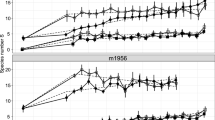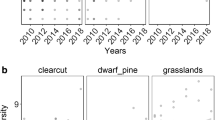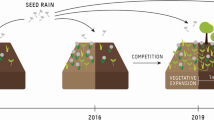Abstract
We investigated the effects of total (TR) or partial (PR) removal of the above-ground biomass of the dominant species on early successional trends in two oldfields in central New Jersey, USA. Our objective was to assess the occurrence of facilitation, tolerance, or inhibition as mechanisms of species replacement in the fields studied. In a 2nd-yr oldfield dominated by Ambrosia artemisiifolia, floristic composition and distribution of species cover changed markedly between the 2nd and the 3rd yr, regardless of the removal treatment. In both TR and PR plots and in control plots dominance shifted from an annual (A. artemisiifolia) to a biennial (Erigeron annuus). This indicates that the presence of the annual dominant is not necessary to promote this successional replacement, and therefore facilitation can be ruled out. Most species present in the 3rd-yr community were late summer and fall invaders which were not initially present. In a 7-yr oldfield dominated by Solidago canadensis, a clonal perennial, very little change in the distribution of species cover could be detected between years. Overall physiognomy remained the same, but there was a gradual change in floristic composition. In this field, TR and PR treatments enhanced vegetational change by allowing the increase in cover of suppressed understory species. Both inhibition and tolerance mechanisms may be involved in the pattern of vegetational change in this field. Finally, we stress that the mechanisms of species replacement operating in early secondary succession are dependent on structural and life history characteristics of the species assemblage on a particular site.
Similar content being viewed by others
References
Abul-Fatih H. A. & Bazzaz F. A., 1979. The biology of Ambrosia trifida. I. Influence of species removal on the organization of the plant community. New Phytol. 83: 813–816.
Allen E. R. & Forman R. T. T., 1976. Plant species removals and old-field community structure and stability. Ecology 57: 1233–1243.
Armesto, J. J., 1984. Experimental studies of disturbance in oldfield plant communities: implications for species coexistence and succession. Ph.D. Dissertation, Rutgers University, New Brunswick, New Jersey.
Armesto J. J. & Pickett S. T. A., 1985. Experiments on disturbance in oldfield plant communities: impact on species richness and abundance. Ecology 66: 230–240.
Bard G. E., 1952. Secondary succession on the piedmont of New Jersey. Ecol. Monogr. 22: 195–216.
Bazzaz F. A., 1979. The physiological ecology of plant succession. Ann. Rev. Ecol. Syst. 10: 351–371.
Bornkamm R., 1981. Rates of change in vegetation during secondary succession. Vegetatio 47: 213–220.
Connell J. H. & Slatyer R. O., 1977. Mechanisms of succession in natural communities and their role in community stability and organization. Am. Nat. 111: 119–144.
Egler F. E., 1954. Vegetation science concepts. I. Initial floristic composition as a factor in old-field vegetation development. Vegetatio 4: 412–417.
Escarré J., Houssard C. & Debussche M., 1983. Evolution de la végétation et du sol après abandon cultural en région méditerranéènne: étude de succession dans la Garrigues du Montpellierais. Oecol. Plant. 4: 221–239.
Gauch H. A., 1982. Multivariate analysis in community ecology. Cambridge Univ. Press, Cambridge.
Gleason M. A. & Cronquist A., 1963. Manual of vascular plants of northeastern United States and adjacent Canada. Willard Grant Press. Boston, MA.
Greig-Smith P., 1983. Quantitative plant ecology. 3rd ed. Univ. of California Press, Berkeley.
Hill M. O. & GauchJr. G., 1980. Detrended correspondence analysis: An improved ordination technique. Vegetatio 42: 47–58.
Hils M. H. & Vankat J. L., 1982. Species removals from a first-year old-field plant community. Ecology 63: 705–711.
Jackson J. R. & Willemsen R. W., 1976. Allelopathy in the first stages of secondary succession on the Piedmont of New Jersey. Amer. J. Bot. 63: 1015–1023.
Jukola-Sulonen E., 1983. Vegetation succession of abandoned hay fields in central Finland. A quantitative approach. Comm. Inst. Forest. Fenn. 112: 1–85.
Keever C., 1979. Mechanisms of succession on old fields of Lancaster County, Pennsylvania. Bull. Torrey Bot. Club 106: 299–308.
Keever C., 1983. A retrospective view of old-field succession after 35 years. Am. Midl. Nat. 110: 397–404.
Lewis, A. J., 1972. The effects of chemical and mechanical manipulation of old-field plant populations: an evaluation of ragweed control techniques. Ph.D. Thesis, Rutgers University, New Brunswick, New Jersey.
Lubchenko J., 1983. Littorina and Fucus: effects of herbivores, substrate heterogeneity and plant escapes during succession. Ecology 64: 1116–1123.
McBrien H., Harmsen R. & Crowder A., 1983. A case of insect grazing affecting plant succession. Ecology 64: 1035–1039.
McDonnell M. J. & Stiles E. W., 1983. The structural complexity of old-field vegetation and the recruitment of bird-dispersed plant species. Oecologia 56: 109–116.
Mellinger, M., 1972. Dynamics of plant succession on abandoned hay fields in central New York State. Ph.D. Thesis. Syracuse University, Syracuse, New York.
Messina F. J., 1982. Food plant choices of two goldenrod beetles: relation to plant quality. Oecologia 55: 342–354.
Messina F. J. & Root R. B., 1980. Association between leaf beetles and meadow goldenrods (Solidago spp.) in central New York. Annals. Ent. Soc. Am. 73: 641–646.
Peet R. K., Glenn-Lewin D. C. & Wolf J. W., 1983. Prediction of man's impact on plant species diversity. A challenge for vegetation science. In: W. Holzner, M. J. A. Werger & I. Ikusima (eds.), Man's impact on vegetation. W. Junk, The Hague. pp. 41–54.
Pickett S. T. A., 1982. Population patterns through twenty years of oldfield succession. Vegetatio 49: 45–49.
Platt W. J. & Weis M., 1977. Resource partitioning and competition within a guild of fugitive prairie plants. Am. Nat. 111: 479–513.
Quinn J. F. & Dunham A. E., 1983. On hypothesis testing in ecology and evolution. Am. Nat. 122: 602–617.
Raynal D. J. & Bazzaz F. A., 1975. Interference of winter annuals with Ambrosia artemisiifolia in early successional fields. Ecology 56: 35–49.
Smith A. P. & Palmer O. J., 1976. Vegetative reproduction and close packing in successional plant species. Nature 261: 232–233.
Sokal R. R. & Rohlf F. J., 1969. Biometry. Freeman, San Francisco, California.
Sousa W. P., 1980. The responses of a plant community to disturbance: the importance of successional age and species' life histories. Oecologia 45: 72–81.
Turner T., 1983a. Facilitation as a successional mechanism in a rocky intertidal community. Am. Nat. 121: 729–738.
Turner T., 1983b. Complexity of early and middle successional stages in a rocky intertidal surfgrass community. Oecologia 60: 56–65.
Werner P. A. & Harbeck A. L., 1982. The pattern of seedling establishment relative to staghorn sumac cover in Michigan oldfields. Am. Midl. Nat. 108: 124–132.
Werner P. A., Bradbury I. K. & Gross R. S., 1980. The biology of Canadian weeds. 45. Solidago canadensis L. Can. J. Plant Sci. 60: 1393–1409.
Whittaker R. H., 1975. Communities and ecosystems. 2nd ed. McMillan, New York.
Author information
Authors and Affiliations
Additional information
Nomenclature follows Gleason & Cronquist (1963)
We thank S. Collins, R. Forman, B. Palser, J. Quinn and E. Stiles for discussion of the ideas presented here and also for comments on the manuscript. Financial support by Hutcheson Memorial Forest Summer grants, and by a Louis Bevier Fellowship from Rutgers University to J.J.A. is gratefully acknowledged. S.T.A.P. gratefully acknowledges the hospitality and support of the Institute of Ecosystem Studies at the Cary Arboretum of the New York Botanical Garden during revision of this manuscript. We thank C. Fernandez Niemeyer for drafting the figures.
Rights and permissions
About this article
Cite this article
Armesto, J.J., Pickett, S.T.A. Removal experiments to test mechanisms of plant succession in oldfields. Vegetatio 66, 85–93 (1986). https://doi.org/10.1007/BF00045498
Accepted:
Issue Date:
DOI: https://doi.org/10.1007/BF00045498




